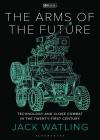Technology and Close Combat in the Twenty-First Century
Bloomsbury Academic, London, 2023, ISBN 9781350352957, 258 pp (paperback), RRP AU$44.99
Author: Jack Watling
Reviewed by: Robin Smith
The Arms of the Future: Technology and Close Combat in the Twenty-First Century by Jack Watling is a seminal work that delves deeply into the transformative impact of emerging technologies on modern warfare with a particular focus on the land domain. As a military strategist, Watling brings a wealth of knowledge and expertise to the table, offering a comprehensive analysis of the future of close combat, drawing significantly on his insights from Ukraine, Iraq, Mali and other conflicts.
At its core, the book explores the intersection of technology and warfare, examining how advancements in technology fields such as autonomous systems, artificial intelligence and cyberwarfare are revolutionising the nature of combat. Watling’s central argument is that these technologies will fundamentally change the way militaries operate and integrate—not only enabling more precise and efficient operations but also introducing new vulnerabilities and ethical considerations. Furthermore, he offers great insights into the impact not just on tactics, techniques and procedures but also on force design, organisational structures and command and control of the joint force.
One of the book’s greatest strengths is its accessibility. Watling’s writing is clear and concise, making the book an invaluable resource for both military professionals and non-experts. He expertly breaks down complex technological concepts, making them understandable to a broad audience. This is no small feat, given the technical nature of the subject matter and the deductions on the impact for the non-military professional.
Watling’s expertise shines through in his highly nuanced discussion of the tactical application of such emerging technologies. He provides a detailed analysis of the potential benefits and drawbacks of autonomous systems, artificial intelligence, space and cyberwarfare. For instance, he explores how autonomous systems could enhance precision and reduce the risk of civilian casualties but also raise ethical concerns about accountability and decision-making. While these are both well-trodden arguments, he brings great insight to what impact this might have in terms of both defence and offence.
The book’s structure is well organised and logical, with each chapter building on the previous one to create a cohesive narrative—leading the reader to the very clear deductions that the author draws. From examining the historical context of technological innovation in warfare to delving into the specifics of emerging technologies and their applications, he takes the reader on a comprehensive journey. He then explores the ethical and strategic implications of these technologies, before concluding with a thought-provoking discussion of the future of close combat and of structural impacts, including on the other domains: maritime, air, space and cyber. He goes so far as to signpost potential ramifications for future acquisition and force postures.
Throughout the book, Watling draws on a range of case studies and expert interviews to illustrate his points. These examples serve to ground the discussion in reality, making the book feel more like a practical guide than a theoretical thought experiment. The inclusion of firsthand insights from military professionals, policymakers and technologists adds depth and nuance to the analysis, providing a detailed view of the complex issues at play.
One of the book’s most compelling aspects is its balanced approach to the benefits and risks of technological advancements in warfare. Watling is neither a technophile nor a Luddite, instead offering a measured assessment of the potential advantages and disadvantages of emerging technologies, with practical examples. He raises important questions regarding the potential for technological over-reliance and the need for careful consideration of the human costs of war. He grapples with the complex moral questions surrounding the development and deployment of machines that can select and engage targets without human intervention. His analysis is thoughtful and nuanced, while also highlighting the risks of unaccountable decision-making and the potential for machines to make life-or-death decisions without human oversight.
The book’s final chapter, which explores the future of close combat, is both thought-provoking and sobering. Watling paints a vivid picture of a future in which autonomous systems, artificial intelligence and cyberwarfare play an increasingly prominent role in modern conflict. He argues that militaries must adapt to these changes, embracing innovation while also addressing the ethical and strategic implications of emerging technologies.
In conclusion, The Arms of the Future is a timely and important contribution to the discourse on modern warfare and technological innovation. Watling’s expertise and balanced approach make the book an invaluable resource for military strategists, policymakers, and anyone interested in understanding the future of conflict and the role of technology in shaping it. Its contemporary nature will assist in making sense of the current conflict in eastern Europe.


